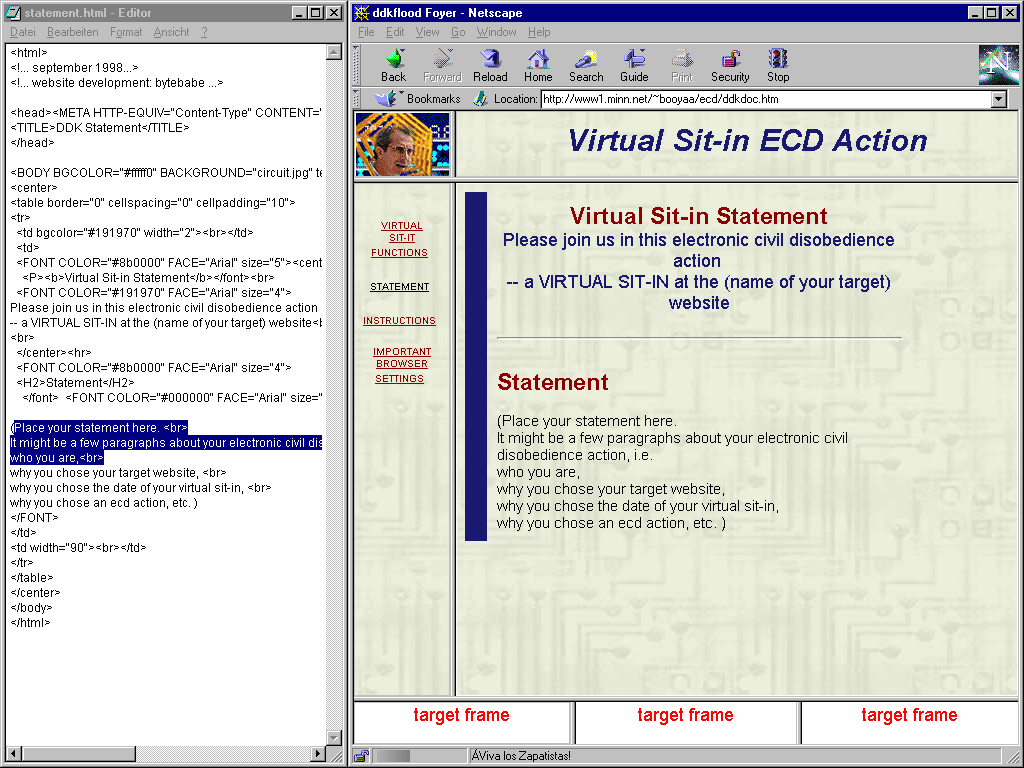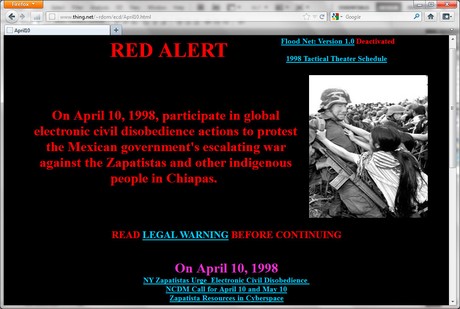This essay accompanies the presentation of Electronic Disturbance Theater's FloodNet as a part of the online exhibition Net Art Anthology.
What is the relationship between data bodies and real bodies? Electronic Disturbance Theater co-founder Ricardo Dominguez cites this as a fundamental question for the group at the time of its founding, and even though this was twenty years ago, it still strikes me as pressing, and unresolved. It is fundamentally a question of presence, a question of the relationship between the real and the virtual.
In 1998, Electronic Disturbance Theater took aim at this very problem. Together, the collective’s founding members—Ricardo Dominguez, Carmin Karasic, Brett Stalbaum, and Stefan Wray—devised a tool by the name of FloodNet. It was a simple Java applet designed to rapidly reload a given webpage, but in the hands of these artists, it became a powerful “weapon of collective presence” and conceptual artwork—an exercise in “tactical poetics.” Their target of choice: the Mexican government.
The Zapatistas had already been resisting the Mexican government and the larger global forces of neoliberalism for more than a decade. And on New Year’s Day in 1994, the group had taken over a series of towns and villages in the southern state of Chiapas, including for a brief period the city of San Cristóbal de las Casas. The date was chosen to coincide with the official launch of NAFTA. In 1996, from the jungles of Chiapas, they issued the “First Declaration of La Realidad for Humanity and Against Neoliberalism.”
“Life is what they owe us: the right to govern and to govern ourselves, to think and act with a freedom that is not exercised over the slavery of others, the right to give and receive what is just.”1
The waves made by these events, among others related to the conflict, far exceeded anything one would have expected. The Zapatista uprising was geographically rather isolated, the conflict physically limited to regions of Chiapas. However, as professor Harry Cleaver wrote, “through their ability to extend their political reach via modern computer networks the Zapatistas [wove] a new electronic fabric of struggle to carry their revolution throughout Mexico and around the world.” The war, which the Mexican state tried so hard to contain, spilled over, becoming a greater global conflict.
The role of computer networks in the struggle, however, exceeded the Zapatistas’ own conscious strategizing. While the rebels did make crucial use of computers as a complement to their existing physical networks of communication, not everyone in Chiapas could log onto the early web. Instead, messages had to be hand-carried from community to community and finally uploaded by the select few who could get online. Once in the hands of those with internet access, Zapatista messages could be broadcast to far-reaching “networks of solidarity,” networks that included foreign activists eager to support the Zapatistas’ cause—activists like the members of Electronic Disturbance Theater.
The members of Electronic Disturbance Theater had been theorizing and experimenting with the possibilities and necessities of online political action for years. In 1996, EDT member Stefan Wray gave a lecture titled “On Electronic Civil Disobedience”—adapting some of the ideas of Thoreau’s famous century-old essay of similar name for the new realm of cyberspace. Wray’s argument expands on the work of tactical media group Critical Art Ensemble (CAE), of which his colleague Ricardo Dominguez had been a member. Formed in Tallahassee, Florida, in the late 1980s, CAE had coined the terms "electronic disturbance" and "electronic civil disobedience," laying the groundwork for Wray’s writing and for EDT’s online activism to come. As Dominguez recounts, “I'd already theorized with CAE about electronic civil disobedience, and the real question was how to do it or how to put it into practice.”2
CAE’s theory of “electronic disturbance” and “electronic civil disobedience” was this: “The streets have become the location of dead capital and [. . .] to seriously confront capital in its current mobile electronic form, then resistance must take place in the same location where capital now exists in greatest concentrations, namely in cyberspace.” Their argument exhibits a breathless exhilaration not uncommon in writing about the possibilities of the early web. As the web became available for public use, artists and writers declared the internet as the new frontier. John Perry Barlow wrote, for instance, that “our virtual selves [are] immune to your sovereignty, even as we continue to consent to your rule over our bodies.”3 However, Wray and EDT contested the usefulness of this kind of attitude, instead maintaining that this “rule over bodies” and embodied struggle for self-determination are of the utmost importance, and that hybridized action that engages data bodies and real bodies both was, in fact, where it was at. Wray cites the Zapatistas’ thoroughly hybrid engagement with computer networks and digital communication as an indicator that electronic and traditional civil disobedience could work cooperatively with each other. The question of how remained, though. What does electronic civil disobedience look like?

Zapatistas and community members bury the victims of the Acteal massacre, 1997. Photo from europazapatista.com
In January of 1998, following the brutal massacre of forty-five people in a chapel in the small village of Acteal by a paramilitary group, a message was posted to online forum The Thing, calling for a “NETSTRIKE FOR ZAPATA.”
“In solidarity with the Zapatista movement we welcome all the netsurfers with the ideals of justice, freedom, solidarity, and liberty within their hearts, to sit-in the day 29/01/1998 from 4:00 p.m. GMT (Greenwich Mean Time) to 5:00 p.m. GMT (Greenwich Mean Time) in the following five web sites, symbols of Mexican Neoliberalism.”4
The call came from an Italian group called Anonymous Digital Coalition. They urged users to manually load and reload the five websites as many times as possible in the allotted time. With enough support, their presence could have an effect similar to a massive street protest or sit-in at a government building, clogging the server infrastructure of their target in the simplest of ways. These actions were a manual kind of DDOS (distributed denial-of-service) attacks, which also directed large amounts of traffic to a target site in an effort to slow it down.
Two months later, that April, Electronic Disturbance Theater and the NYZapatistas sent out another call to action on The Thing. This time, the target would be Mexican president Zedillo’s website. And this time, thanks to FloodNet, the virtual sit-in would be automated, allowing the protest to span a 24-hour hour period rather than a single hour. The FloodNet applet was hosted on a web page on the servers of The Thing, a kind of ISP for artists and activists. It was embedded in a small frame that bore the image of Mexican president Zedillo floating in front of a pentagon. The page was bordered at the top and left by frames featuring collaged images of the Zapatistas, with text about the action at the center. And at the bottom, the top portion of the target page could be glimpsed, with official insignia reloading again and again as long as the browser window stayed open, thereby slowin it down with excess traffic. Dominguez reported, "The FloodNet URL hit Zedillo's site a total of 8141 times. Many reported that Zedillo's site was no longer responding."
EDT continued to develop the virtual sit-in as a tactic throughout 1998. An eight-hour action in September, launched from the Ars Electronica festival, drew perhaps 10,000 participants, who generated at their peak an estimated 600,000 requests per minute for each of the three targets: the Pentagon, Zedillo's website, and the Frankfurt Stock Exchange.
In 1999, FloodNet played an important role in ToyWar, a large-scale online action by Zürich- and Vienna-based art collective eToy, who lost control of their URL to an online toy-seller after a hearing in a California courtroom. ToyWar was described as a game in which the goal was to bring down the stock price of etoys.com, but it also gave form to a general resistance to increasing corporate control of the web. Although their approach was quite distinct from the ur-corporate aesthetics style of etoy, FloodNet jumped into the fray and created a coordinated action.
FloodNet didn’t just extend the possibilities of the virtual sit-in functionally; it also brought the protest into the realm of conceptual art and “tactical poetics.” The Java applet, in addition to reloading the page, was designed to allow users to enter a “personal message” that would be sent to the server error log. The result would be a message along the lines of “human rights not found,” “justice not found,” and so on. EDT used the functions of the browser against it to politicize the aesthetic of the server error. The manipulated “404 not found” message came to represent what Dominguez called a “negative dialectics that allows us to see not what is hidden in the server of the government or a corporation,” as perhaps a hacker might be interested in, “but what is just not even part of its discourse.”5

Screen shot of FloodNet DDK (1999).
The “tactical poetics” of FloodNet followed in the footsteps of the conceptual art practices of Fluxus, presenting a protocol-based artwork that was similar to Fluxus event scores and instruction-based works. It was also influenced by earlier avant garde and radical groups such as the Dadaists, the Lettrists, and the Situationists both in its articulation of an “online aesthetic of disturbance”6 and in its focus on the theatre as a mode for conveying this.
This notion of theatre was crucial to FloodNet, as the artists’ interest was in the “performance and performativity of code,” over the effectivity or the efficiency of the code itself. Carmin Karasic, who spearheaded the technical aspects of the project along with Brett Stalbaum, recalls the resistance among some hackers when it came to the group’s plans for electronic civil disobedience:
“These hackers questioned our ‘wimpy’ use of technology. Instead of slowing down a company’s or government’s server or website, they would have preferred to close it all together, or to change the text on the website.”7
The precarious relationship of FloodNet to more hardcore hacking practices has made the project’s legacy and afterlife an interesting one; In the years since the initial implementation of FloodNet, EDT has found itself entangled in inquiries about hacking and cyberterrorism, mentioned in government hearings on cyberterrorism at the new millennium, and featured in numerous articles. During the September 1998 FloodNet action, the Pentagon launched an immediate counter-attack, redirecting protestors’ browsers to a Java applet that caused participants' browsers to load and reload an empty window, forcing them to restart. "Our support personnel were aware of this planned electronic civil disobedience attack and were able to take appropriate countermeasures," a Defense Department representative told Wired. EDT saw this as an illegal use of military power for law enforcement purposes. As for their virtual sit-in, EDT believed that their actions were entirely legal, although internet security experts at the time noted that they could be a violation of federal law. In some ways, the virtual sit-ins pioneered by EDT are a more centralized version of the DDOS attacks made famous by the hacker group Anonymous; such activity today is now aggressively prosecuted.
But Electronic Disturbance Theater had little interest in playing the role of a shadowy underground resistance. Rather, they simply wanted to show that there were thousands of users watching, ready to act in solidarity with the Zapatistas in whatever ways possible. Further, they eschewed the notion of the necessity for a hacker skill set in order to be an effective online activist. They harnessed a mundane function of the internet in a way that your average user could replicate, even creating a do-it-yourself “Disturbance Developers Kit” kit for widespread public use.

Screen shot of announcement for April 10, 1998 action, hosted on The Thing.
FloodNet’s mundane engagement of the internet’s infrastructure makes it all the more interesting today. EDT used the native language of the internet to create gaps in its functionings. Brett Stalbaum notes that part of EDT’s thinking was an awareness that “there is an important distinction between representation and engagement.”8 Rather than amplifying a representation of the struggles of the Zapatistas—by way of, say, an awareness campaign in wealthy western countries—the group engaged the Mexican government with direct action.
The question of representation versus engagement when it comes to online activism has re-emerged as a central problem in recent years. The accelerated rise of social media platforms has caused a radical shift. Activists can disseminate their messages far and wide on platforms like Twitter and Facebook. On these platforms, communities have been extended beyond their geographical limitations. One can organize with greater ease and reach. There is always the possibility and aim of going viral. But most of these and the other popular forms of online activism belong to the realm of representation and do little for engagement. The internet has become a fantastic place to make things visible, but an increasingly difficult place to cause a disturbance.
With FloodNet, EDT showed that symbolic and direct action could be combined. The project had a direct effect on the infrastructure of its target, but it was framed as a symbolic intervention, the inscription of an error message onto a remote server. For Dominguez, the affective and the effective potential of the project could not be separated from one another:
The question of aesthetics, at least for us, creates a disturbance in the “Law” to the degree that it cannot easily contain the “break” and it is forced to enter into another conversation—a conversation that power-as-enforcement may not want to have.
Spreading a hashtag is one way to use the infrastructure built for us by Silicon Valley, but while it has many merits, it is too reliant on and easily contained by the intended functions of the social media system. Where are the gaps? The weak points? How can we create the break that cannot be contained, and force the conversation that power-as-enforcement does not want to have? FloodNet sets a precedent for online art and activism that feeds off of the network’s own indeterminacy and an awareness that the virtual is closer to the real than we imagine.
Notes:
1. EZLN, “First Declaration of La Realidad for Humanity and Against Neoliberalism, 1996.
2. Ash Eliza Smith and Ricardo Dominguez, Rhizome interview, https://rhizome.org/editorial/2016/jan/26/interview-with-ricardo-dominguez, 2016
3. John Perry Barlow, "A Declaration of the Independence of Cyberspace," https://www.eff.org/cyberspace-independence, 1996
4. The Thing, http://www.thing.net/~rdom/ecd/anondigcoal.html
5. Dominguez, Ricardo. Interview by Aria Dean. Phone recording. Los Angeles, November 7, 2016.
6. Ibid.
7. Leonie Tanczer, "Hacking the Label: Hacktivism, Race, and Gender," Ada: A Journal of Gender, New Media, and Technology, Issue #6, http://adanewmedia.org/2015/01/issue6-tanczer/, 2015
8. Stalbaum, Brett. Interview by Aria Dean. Phone recording. Los Angeles, November 15, 2016.
